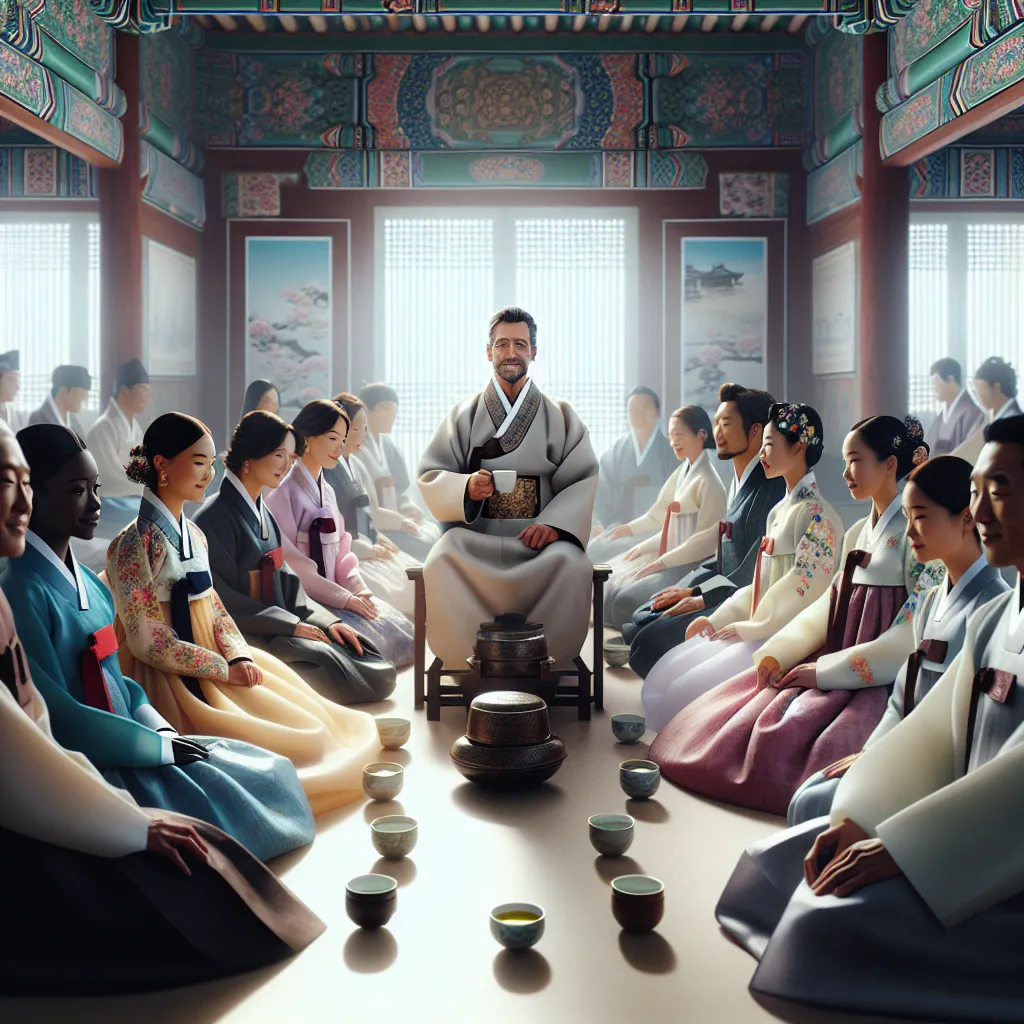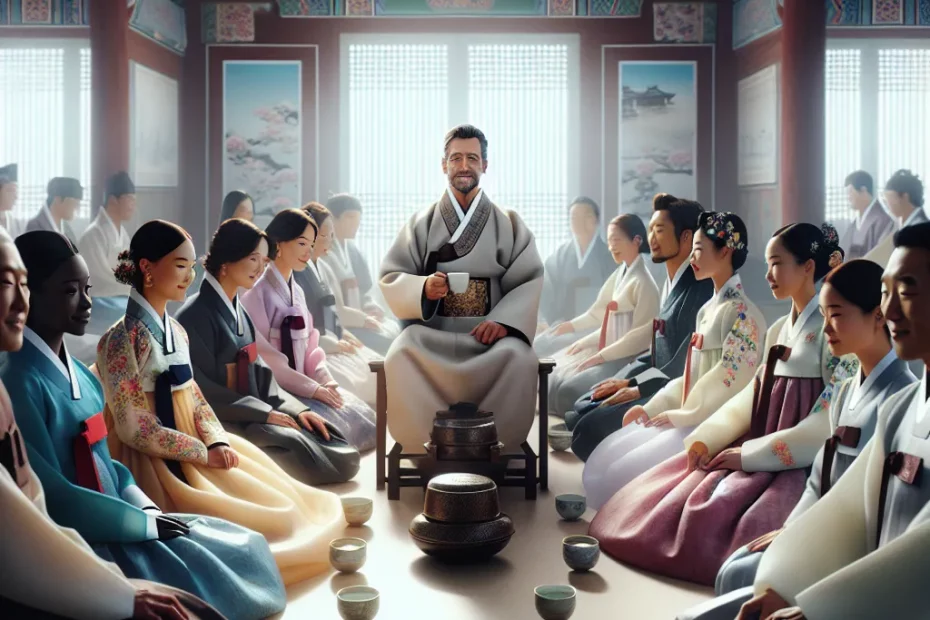Tea culture in Korea is a rich and vibrant tradition that dates back centuries. From the serene tea ceremonies to the diverse range of tea types enjoyed by the people, Korean tea culture is a reflection of the country’s history and values. The history of tea in Korea is a fascinating journey that showcases the deep-rooted connection between tea and Korean society. Traditional Korean tea ceremonies are not just about drinking tea; they are a harmonious blend of mindfulness, respect, and appreciation for the art of tea-making. Popular types of Korean tea, such as green tea and barley tea, offer a unique taste experience that captivates the senses. In modern times, Korean tea culture has evolved to embrace new trends while staying true to its heritage. Exploring the dynamic landscape of Korean tea culture reveals a tapestry of flavors, rituals, and stories that continue to enchant tea enthusiasts around the world.

The History of Tea in Korea
Tea culture in Korea dates back over a thousand years, with a rich and fascinating history that has shaped the way tea is enjoyed and appreciated in the country. The tradition of tea drinking in Korea can be traced back to the Three Kingdoms period (57 BC – 668 AD), where tea was initially used for medicinal purposes before evolving into a beloved beverage for social and cultural gatherings. 🍵
The Three Kingdoms Period
During the Goryeo Dynasty (918-1392), tea became an integral part of Korean culture, with the spread of Buddhism playing a significant role in popularizing tea ceremonies and rituals. Monks cultivated tea plants and shared their knowledge of tea preparation, leading to the development of unique Korean tea traditions. The practice of tea drinking was not only a way to enjoy the flavors and aromas of different teas but also a form of spiritual meditation and self-reflection. ☕
The Goryeo Dynasty
One of the most famous types of tea in Korea is “Hwagae Tea,” which originated during the Joseon Dynasty (1392-1910). This tea is made by roasting green tea leaves over a fire, giving it a distinct smoky flavor and aroma. Hwagae Tea became a favorite among the royal court and aristocrats, symbolizing elegance and sophistication. The meticulous process of preparing and serving this tea reflected the attention to detail and respect for tradition that defined Korean tea culture. 🌿
The Joseon Dynasty
In modern times, tea culture in Korea continues to thrive, with traditional tea houses coexisting alongside trendy tea cafes in bustling cities. Green tea, barley tea, and traditional herbal teas remain popular choices among Koreans, who appreciate not only the taste but also the health benefits associated with different types of tea. The practice of “dado” or tea ceremony is still observed, with people gathering to enjoy tea together and engage in meaningful conversations. 🍵
The history of tea in Korea is a testament to the enduring legacy of this beloved beverage and its significance in Korean society. From ancient rituals to modern-day trends, tea continues to be a symbol of hospitality, culture, and tradition in Korea, inviting people to slow down, savor the moment, and appreciate the simple pleasures of life. 🌱
Traditional Korean Tea Ceremonies
In the realm of Korean traditional culture, tea ceremonies hold a revered place, embodying elegance, mindfulness, and a deep connection to nature. Rooted in centuries-old practices, these ceremonies serve as a window into the rich tapestry of Korean heritage and philosophy. 🍵✨
The Essence of Korean Tea Ceremonies
The essence of Korean tea ceremonies lies in the meticulous preparation and presentation of tea, which is viewed as a form of art in itself. Each step, from selecting the finest tea leaves to brewing the perfect cup, is infused with symbolism and meaning. The gentle ritual of pouring and serving tea reflects the values of respect, harmony, and tranquility that are deeply ingrained in Korean society. ☕🌿
Darye: A Formal Ritual
One of the most well-known Korean tea ceremonies is “Darye,” a formal ritual that dates back to the Joseon Dynasty. During Darye, the host prepares tea for the guests with graceful movements and precise gestures, creating a serene atmosphere conducive to contemplation and conversation. The act of sharing tea fosters bonds between individuals and promotes a sense of community and unity. 🌸🍃
Regional Variations
In addition to Darye, there are various regional tea ceremonies in Korea, each with its own unique customs and practices. For example, the “Hwagwan Darye” in the royal court was a highly elaborate ceremony reserved for royalty and nobility, showcasing the opulence and refinement of the aristocratic class. On the other hand, the “Sujeongjeon Darye” held in Buddhist temples emphasizes meditation and spiritual reflection through tea drinking. 🏯🙏
The significance of Korean tea ceremonies extends beyond the simple act of drinking tea; it is a way to honor tradition, cultivate mindfulness, and appreciate the beauty of the present moment. Through these ceremonies, Koreans pay homage to their cultural heritage and seek harmony with nature and each other. So, the next time you sip a cup of Korean tea, remember the centuries of wisdom and artistry that have shaped this time-honored tradition. 🍵🌺
In conclusion, Traditional Korean Tea Ceremonies are not just about tea; they are a reflection of the Korean spirit, blending grace, mindfulness, and reverence for nature into a harmonious ritual that transcends time. Let us raise our cups to the beauty and serenity of Korean tea culture! 🍵🌿
Popular Types of Korean Tea
In Korea, tea culture has a rich history that dates back centuries. Korean teas are not only known for their unique flavors but also for their numerous health benefits. Let’s explore some of the popular types of Korean tea that have captivated tea enthusiasts worldwide! 🍵✨
Green Tea (녹차)
Green tea holds a special place in Korean tea culture. Known for its fresh and grassy flavor, Korean green tea is rich in antioxidants, making it a popular choice for those seeking health benefits. The most famous Korean green tea is “Ujeon”, which is made from the first flush of young tea leaves.
Barley Tea (보리차)
Barley tea, known as “Bori-cha”, is a staple in Korean households. This caffeine-free tea has a nutty and toasty flavor, perfect for enjoying both hot and cold. Barley tea is not only refreshing but also aids in digestion, making it a popular choice after meals. 🌾❄️
Jujube Tea (대추차)
Jujube tea, or “Daechu-cha”, is made from red dates and has a sweet and soothing taste. This tea is often consumed during the winter months for its warming properties. Jujube tea is believed to boost the immune system and improve blood circulation, making it a favorite during the cold season. 🍵❤️
Ginseng Tea (인삼차)
Ginseng tea, known as “Insam-cha”, is highly valued for its medicinal properties. Korean ginseng is renowned for its ability to increase energy levels and improve overall health. Ginseng tea has a slightly bitter taste with earthy undertones, and it is often enjoyed for its rejuvenating effects. 💪🍵
Corn Silk Tea (옥수수수염차)
Corn silk tea, or “Oksusu-suyeom-cha”, is made from the silky threads found on corn cobs. This tea has a mild flavor with a hint of sweetness and is known for its diuretic properties. Corn silk tea is often consumed for its ability to promote kidney health and aid in detoxification. 🌽🍵
These are just a few examples of the diverse range of Korean teas available, each offering a unique flavor profile and health benefits. Whether you’re a tea connoisseur or simply looking to explore new flavors, Korean teas are sure to delight your taste buds and nourish your body! 🌿🍵
Modern Trends in Korean Tea Culture
In recent years, the Korean tea culture has been experiencing a remarkable transformation, blending traditional practices with modern influences. This fusion has given rise to innovative trends that are shaping the way tea is consumed and appreciated in Korea and beyond. 🍵✨
The Rise of Tea Cafes
One of the prominent trends in Korean tea culture is the increasing popularity of tea cafes. These trendy establishments offer a wide variety of traditional Korean teas, as well as modern tea creations that cater to the tastes of the younger generation. With stylish and cozy interiors, tea cafes have become social hubs where people gather to relax, socialize, and enjoy a cup of tea. ☕🌿
Revival of Tea Ceremonies
Furthermore, there has been a growing interest in tea ceremonies among the younger population in Korea. While tea ceremonies have long been a part of Korean tradition, they are now being reimagined and modernized to appeal to a new audience. Young tea enthusiasts are embracing the meditative and mindful aspects of tea ceremonies, finding solace in the ritual of preparing and savoring tea. 🍵🌸
Innovative Tea Blends and Flavors
In addition to traditional teas, Korean tea culture is also embracing innovative tea blends and flavors. Tea artisans are experimenting with unique ingredients and flavor combinations to create teas that are both delicious and visually appealing. From floral-infused teas to fruit-flavored blends, these modern creations are redefining the boundaries of traditional tea culture. 🌺🍵
Tea Pairing
Moreover, the concept of tea pairing has gained popularity in Korea, with tea being paired not only with traditional Korean snacks but also with international cuisines. Tea pairing events and workshops are becoming increasingly common, offering participants the opportunity to explore the intricate flavors and aromas that different teas can bring to a dish. 🍵🍴
Overall, the modern trends in Korean tea culture reflect a dynamic and evolving landscape where tradition meets innovation. As the appreciation for tea continues to grow, we can expect to see more exciting developments that will further enrich the tea culture in Korea and inspire tea enthusiasts worldwide. 🍵💫
In conclusion, the fusion of traditional practices with modern influences is shaping the future of Korean tea culture, making it an exciting and vibrant scene that continues to captivate tea lovers around the globe. Let’s raise our teacups to the ever-evolving world of Korean tea culture! 🍵🌏
Tea culture in Korea is a rich and vibrant tradition that has been passed down through generations. From the ancient history of tea in Korea to the modern trends shaping the tea culture today, it is evident that tea holds a special place in Korean society. The traditional Korean tea ceremonies, with their meticulous rituals and deep symbolism, offer a glimpse into the profound respect and appreciation for tea in Korean culture. Popular types of Korean tea, such as green tea and barley tea, showcase the diverse flavors and health benefits that tea has to offer. As Korean tea culture continues to evolve, embracing new trends and innovations, it is clear that the love for tea in Korea will endure for generations to come.
